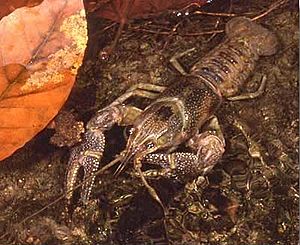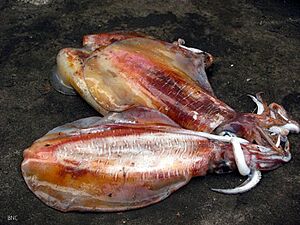Escape reflex facts for kids
Imagine needing to get out of danger super fast! Many animals have special escape reflexes that help them do just that. These are like automatic, lightning-quick reactions that protect them from harm. They use special parts of their nervous system to react incredibly quickly.
Contents
What are Escape Reflexes?
Escape reflexes are automatic body movements that help an animal get away from danger very quickly. They are different from regular movements because they happen without the animal having to think about them. This speed is super important for survival!
Crayfish: The Tail Flick
Crayfish have an amazing escape trick! If something scares them, tiny hairs on their tail fan send a super-fast signal. This signal travels through special "giant" nerves that are connected in a unique way, almost like a direct wire. This makes their tail flick powerfully, shooting them away from danger in a blink. These special nerves skip the usual brain processing, making the reaction time incredibly short.
Squid: Jet Propulsion
Squids are masters of quick getaways using jet propulsion. They have a very large nerve cell, called the squid giant axon, which can be up to 1 millimeter wide! This giant nerve helps control their water jet system. When a squid needs to escape, this nerve sends a signal that makes it shoot water out, pushing the squid away at high speed. This amazing system was studied by a scientist named J.Z. Young in the 1930s.
Fish: The C-Start
Most fish have a special escape move called the "C-start." If a fish senses danger, special large nerve cells called Mauthner cells help them react. These cells are found in the back part of the fish's brain. They work together to make the fish's body bend into a "C" shape, then straighten out, pushing them away from the threat very quickly. These cells are unique because they use both chemical and electrical signals to communicate.
Humans: Our Quick Reactions
Even humans have some escape reflexes! For example, if something suddenly comes towards your head, you might automatically duck. Or, if you accidentally touch something very hot or sharp, your hand pulls away super fast before you even realize what happened. These reflexes happen without you consciously thinking about them. Your brain only understands what happened a moment after the reflex has already protected you.
Why are Escape Reflexes Important?
Escape reflexes are incredibly important for an animal's survival. They allow animals to avoid predators or dangerous situations in a fraction of a second. This quick reaction time can be the difference between life and death, helping animals stay safe and alive in the wild.
Images for kids




